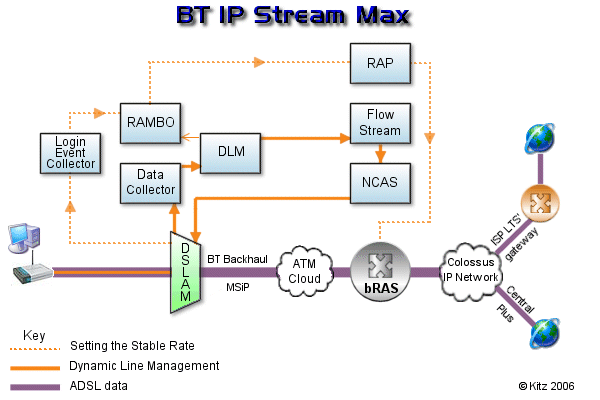 |
|
 |
| Support this site |
| |
|
| |
How DSL Max works |
||||||||||||||||||||||
Maximum Speeds Although MaxDSL is advertised as "Up to 8Mb", in reality even
if you have an excellent line and manage to sync at the full 8128 kbps,
the very maximum throughput speed you can receive will be nearer 7Mb
due to ATM and other overheads.
More information about the actual dslMax products themselves can be found
on my maxDSL page.
Sync speed is the rate which you connect (synchronise) to the local
exchange at. This speed is negotiated between your router and the DSLAM
at the exchange and will be subject to line conditions such as your
SNR Margin and line length. When an End User logs on with maxdsl an "Event" will be sent to the DSLAM. Your modem/router will negotiate with the DSLAM what speed your line can achieve. Details of these events are monitored by the DLM. Some users may notice a slight increase in the time it takes to sync to the exchange due to this negotiation process. To give your line the best chance at attaining higher and more stable speeds it is recommended that you follow the tips on my low SNR page. Maximum Stable Rate. (MSR) - Training / Stabilisation Period. During the first 10 days on MAX details of your logon/sync events are recorded in an Event Collector which every 15 minutes then sends this information to RAMBO. RAMBO collates events from all users and analyses each users data over a 10 day period to find the Maximum Stable Rate (MSR) for their particular line. The MSR is set from the lowest achieved rate over this 10 day period rounded down to the nearest 0.5Mb. A notification after this period is sent to the RAP profile and your ISP. During your first ever log in to maxdsl, information is sent from RAMBO over to RAP which forwards the details over to the DSLAM at the exchange in order to set your sync speed. Sync speeds (and Data Rates) for poorer lines can and will vary over the this training period and users may experience frequent disconnects and slower speeds until their most stable rate is found. The 10 day training period is often referred to as the "Stabilisation Period", and will only commence once a line has been in sync for 15 mins or more - not necessarily the date from when the line is maxed. There is a rolling 10 day period which allows flexibility if for some reason sync is not attained during the immediate period after the line being maxed (such as holidays and the router is switched off). There's been a lot of talk/hype about the MSR, but in day to day use it doesn't really
do much as its main purpose is to set your Fault Threshold Rate. With Datastream products, BTw will collate the relevant
information but not send it over to the bRAS since this equipment is owned
by the DS provider. Instead the information is sent in a report to the
DS ISPs so that they can apply the speed to their own bRAS. Once the 10
days have passed BT will also advise the DS provider the stable rate. Once your MSR has been set, BTw use this figure to calculate your Fault Threshold Rate which is in the region of 70% of your MSR. BTw will only investigate speed related faults if your speed drops to below the Fault Threshold Level.
The Data Rate is the fastest speed (throughput) that you will be
able to download at and is profiled by BT at the bRAS. For more information see bRAS / IP profile page. The Data Rate should not be confused with the MSR. Stuck bRAS profile. Many customers have found themselves with the dreaded
"Stuck bRAS profile". This is when despite constantly syncing at much
higher speeds, your IP profile remains stuck at 1mb/2Mb. For some reason
the DLM system hasn't picked up that you have been upgraded from your
traditional adsl speed to your new sync speed. SNR /SNR Margin The Signal to Noise Ratio on the max product is more flexible than on traditional
adsl. On the older fixed line speed products an SNR Margin of
less than 6dB suggested that there was a problem with the line. Dynamic Line Management (DLM) - Ongoing Process When the user logs on they send information (line data) to the DSLAM including
details of any errors on the line. If any changes need to be made the DLM sends the information via the flow
stream to NCAS. The DLM process is carried out every time you
are connected and not just within the first 10 days. © April 2006
|
All rights reserved
Unauthorised reproduction prohibited
|
|
|
|
